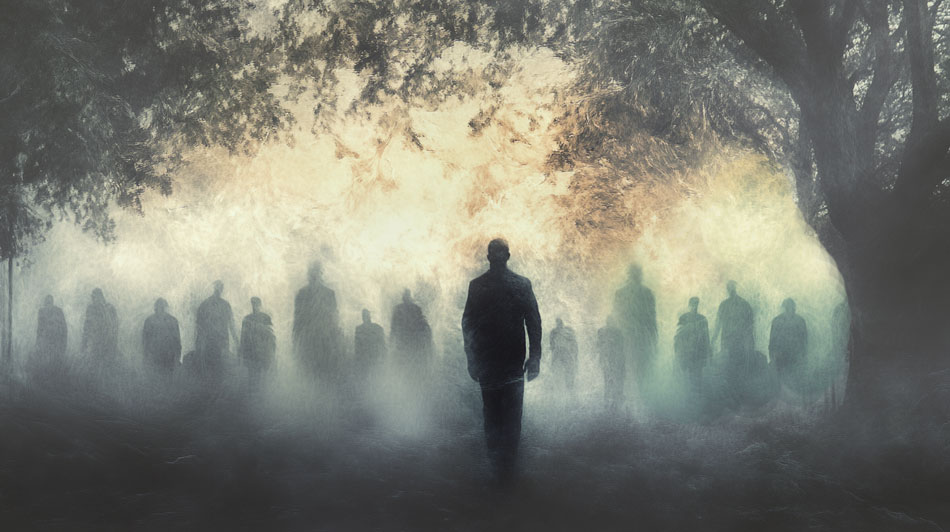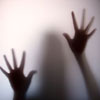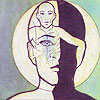Spirit Possession
 by Fiona Bowie
by Fiona Bowie
Carl Wickland – Thirty Years Among The Dead
One of the earliest written accounts of spirit possession or ‘obsession’ in a modern clinical setting is that of Carl Wickland (1861-1945), a Swedish-American physician and psychologist with an interest in paranormal research, who practiced in Chicago and California. He invented a static electricity machine known as a Wimhurts, which he used to send low voltage electric shocks to the head and spine of patients he believed to be suffering from the effects of an attached or obsessing spirit. Wickland spent over thirty years studying the phenomenon of what he termed ‘obsession’ and recording verbatim conversations with the spirits he was treating. Wickland and his wife, a gifted psychic and medium, were interested in Spiritualism, which provided a context in which his work could be understood. His wonderful, detailed account of his practice was first published in 1924 under the title Thirty Years Among The Dead.
Among Wickland’s first encounters with spirits bothering the living were cases in which individuals underwent a sudden and often dramatic personality change after dabbling in the occult, using a Ouija Board or inviting a spirit to communicate through automatic writing. One of the first cases he records is that of a Mrs B.:
“…whose attempts at automatic writing led to mental derangement and altered personality. Normally she was amiable, pious, quiet and refined but became boisterous and noisy, romped about and danced, used vile language, and, claiming she was an actress, insisted upon dressing for the stage, saying that she had to be at the theater at a certain time or lose her position. Finally she became so irresponsible that she was placed in an asylum (Wickland, 1974:28).”
The dangers of dabbling in the occult are often stressed in Spiritualist, Theosophical and other literature. There are parallels with shamanic traditions in which the initial presentation of spirits possessing a person is often regarded as a form of sickness. For shamanic (or mediumistic) powers or gifts to evolve, a team of spirit helpers is necessary, whether it be the spirit animals of the shaman or the spirit guides of the medium. These then act as intermediaries and help to form a protective boundary between the open and vulnerable energy and body of the shaman or medium and the spirit world. Without this help, the individual patient or medium, like the man in Jesus’s parable in Matthew’s Gospel, or the curious experimenting with a Ouija board, can be like an empty and welcoming house for any spirits who wish to enter.
Mrs Wickland proved to be sensitive to obsessing spirits. They could enter and control her on a temporary basis, speaking through her in such a way that Carl Wickland was able to engage them in conversation. His task was to instruct the spirits as to the true state of affairs and persuade them to ‘go to the Light’. There was often a deceased relative or friend trying to reach the earthbound spirit, from whom they may have fled in the past, as not fully understanding that they had died, the spirit would think that they had encountered a ghost. Recalcitrant spirits obsessing patients in the sanatorium where Wickland worked, ejected from their hosts by his electric shock treatment, could if necessary be forcibly removed from Mrs Wickland by the ever-growing team of spirit helpers, known as ‘the Mercy Band’, and taken to a spirit hospital where the healing and reorientation process could begin.
It may seem strange to conceive of not knowing that one has died, especially when viewing one’s own corpse, but as a spirit released by Wickland explained:
“…death – the freeing of the spirit from the body – is so simple and natural that a great majority do not, for a longer or shorter period, realize the change, and owing to a lack of education concerning the spiritual side of their natures, they continue to remain in their earthly habits (1924:29).”
Such spirits were often, they maintained, attracted to the ‘magnetic aura’ of mortals, thus possessing or obsessing their victim, although both spirit and mortal might be unaware of what had happened. The consequences of this malicious or unintended intrusion ‘became the cause of untold mischief and misery, often producing invalidism, immorality, crime and seeming insanity’ (ibid.). Wickland, and others, also attribute many actual and attempted suicides to the actions of obsessing spirits who strive through their victim to re-enact or bring about their own death.
It was released spirits who both explained and demonstrated the process that the Wicklands subsequently adopted in their work:
“These intelligences also stated that by a system of transfer, that is, by attracting such obsessing entities from the victim to a psychic intermediary, the correctness of the hypothesis could be demonstrated and conditions could be shown as they actually exist. After this transference of psychoses the victims would be relieved, and the obsessing spirits could then be reached by the advanced spirits, who would care for them and instruct them regarding the higher laws of life (ibid.29).”
The victim, or patient, often showed immediate and permanent relief from what had been causing their distress (although they might be obsessed by another spirit in the future), just as the Gadarene Demoniac was immediately restored to his right mind, and could resume a normal life, when Jesus cast out the Legion of unclean spirits.
The next step in Wickland’s encounter with spirits involved the dissection of a woman’s cadaver. He was on his own, the medical students having left the building, when he distinctly heard a voice say ‘Don’t murder me!’ Wickland assumed that the voice must have come from the street and didn’t think any more of it. The following day he continued his work and was slightly startled to note a rustling coming from a newspaper lying on the floor, but did not pay any particular attention to it or mention it to his wife. A few days later, following a psychic circle held in their home, Wickland noted that his wife remained in a semi-trance condition and stepped forward to ascertain the reason. The controlling spirit went to strike him, saying angrily:
“‘I have some bones to pick with you!’
After a period of struggle with the stranger [in the body of his wife] I asked what the trouble was.
‘Why do you want to kill me?’ the entity demanded.
‘I’m not killing anyone,’ I answered.
‘Yes you are – you are cutting on my arm and neck! I shouted at you not to murder me, and I struck that paper on the floor to frighten you, but you wouldn’t pay any attention.’
Then, laughing boisterously, the spirit added with great hilarity: ‘but I scared the other fellows!’ [the medical students, who had refused to return].
It was necessary to explain at great length the actual situation of the spirit, who said her name was Minnie Morgan, but finally she understood and left, promising to seek a higher life. (ibid:32).”
This case is interesting in that there is no actual human victim of possession. The confused spirit needs help if he or she is to progress; failure to do so increases the chances that the earthbound spirit will continue to trouble the living, either as a haunting ghost, a nuisance poltergeist or as a possessing entity. Wickland’s practice, as with the Spiritist mediums of the Vale do Amanhecer described by Emily Pierini (2013), therefore has two parts. There is the healing work for those who come to the mediums, and the de-obesssion or spirit release work for those who have died and failed to move on as they should.
Wickland was a compassionate and intelligent observer and recorder of hundreds of such encounters. As in the Gadarene Demonic account, knowing the name of the person dealt with was an important first step in engaging with the spirit or spirits. Often they would have forgotten their previous identity and had to be led back into their earth memories in order to help them rebuild a narrative to the point at which they had died. Until this happened, many refused to believe that they had in fact left their bodies. Getting the spirit to observe the body of his wife, who they were controlling temporarily, was sometimes a useful device, a way of persuading a spirit that they were no longer in their own body.
One of the fascinating aspects of Wickland’s accounts is the description of what it feels like to be trapped in, or to occupy, another’s energy field. Entities often describe feeling cramped, of disliking having to share a space with others (the victim and often other spirits) who they don’t know or want to be with, of intrusive conversations, and of being restlessly moved from one place to another. They may have to fight to gain control of their victim, as when a spirit who believes themselves to be sick persuades the victim to become a chronic invalid, or have to share the victim’s mind and body with other obsessing spirits, awaiting their turn to influence the host. In some cases the spirit is in conscious control of the process and may hop from one victim to another to evade ‘capture’. Wickland found his electric shock treatment to be very effective in forcibly removing spirits from a victim. They could then be brought by the spirit helpers to his wife in a Spiritualist home circle (a regular séance that took place in the Wickland’s home), where they would be given the opportunity to take control of her body. They appeared unconscious of having entered Mrs Wickland, and often reported feeling better than they had for years. The spirits would generally recognize Carl Wickland as the person who had ‘tortured them with fire’ (i.e. administered the electric shock) ejecting them from their victim’s energy field. The close link this suggests between the physical body of the host and the discarnate spirit is also indicated by the ways in which possessing spirits seek to satisfy their cravings for drugs, alcohol, and sex (as well as their emotional energies) via the induced indulgence of their hosts. It seems that we are not dealing with immaterial beings, but ones that, like electricity, X-Rays or sound, are invisible to the eye but visible through their effects.
Wickland carefully recorded the name and biographical details of the spirits, and wherever possible sought to verify the details through subsequent research. This was both to gain a patient history of the spirit in order to help them move on, and to further psychic research. If, for instance, he could establish who the spirit was, when and how they left their body, and when, why and how they found their victim, they could more easily be persuaded that they had indeed died and were being troublesome and perhaps selfish in remaining with the person they were obsessing. Relatives of the patient or sometimes the patient themselves were often present at these séances, although this was not necessary. It could be useful in identifying the obsessing spirit or spirits and in filling in background information that might help persuade them of the circumstances of their death. The attached or possessing spirits were often known to the victim or to other members of their family, and might be a relative, neighbor or casual acquaintance, but this was not always the case. When an unknown discarnate entity gives biographical details unknown to anyone present, which are later confirmed, the evidential case for taking a Spiritualist rather than purely psychological interpretation of possession is greatly strengthened.
Edith Fiore – The Unquiet Dead
A clinical psychologist by training, Edith Fiore was one of the first therapists since Carl Wickland to rediscover and incorporate a diagnosis of spirit possession into her practice. The techniques are similar to Wickland’s, although she uses hypnosis rather than mediumship to engage with the spirits possessing her clients in what she terms ‘hypnoanalytic therapy’. The entranced patient takes the place of the medium in giving voice to the possessing spirits, or speaking out of their own subconscious knowledge of what is taking place within and around them. As well as engaging the patient’s Higher or subconscious Self and any attached spirits in direct conversation, Fiore uses a system of signals in which the patient raises a finger to give a ‘yes’ or ‘no’ answer to a direct question. While Fiore invites her patients and readers to be open to the possibility that life continues after death, and that both the so-called dead, and past lives can influence a person in this life, accepting this hypothesis is not essential for a successful therapeutic outcome. If the correct techniques are followed patients can be relieved of a range of seemingly intractable mental and physical conditions.
Out of more than five hundred patients Fiore saw in her clinic over a seven-year period, suffering from a wide range of psychological and psychosomatic symptoms, she estimated that at least seventy percent were possessed, and that this was the cause of their disease. Most were relieved of their symptoms through her spirit release techniques. Some had only one entity, others were hosts to several, and occasionally patients had fifty or more attached entities (1988:3). Treatment in such cases could take time as each entity has to be ‘found’, engaged with and encouraged to leave the host. The Unquiet Dead gives details and transcripts of five anonymized case studies involving apparent spirit possession.
A typical, if rather complex, case study presented by Fiore is that of ‘Peter’, a successful computer analyst in his mid-thirties. I will summarize this case in some detail as it gives a vivid impression of the way spirit obsession and release works, both in Fiore’s practice and more generally. The case is interesting not only because it involves a number of entities, each having a different, discernible affect on Peter’s life and personality, but also because of the interplay between obsessing or attached spirits and Peter’s own choices in his current life and an ostensible past life, choices which left him particularly vulnerable to possession.
Peter attended Fiore’s clinic as his life was in a mess. He suffered from severe anxiety attacks, which were affecting his work and relationships. He couldn’t concentrate and his memory was very poor, with periods in which he could not remember what he had just been doing, as if he had been absent from his body. Although generally kind and good-natured, Peter was subject to sudden mood swings and bouts of cruelty, directed towards those close to him such as his family, colleagues and animals. Peter had problems with relationships with women, including his (third) wife, to whom he no longer felt physically attracted. He was also drinking heavily, generally in rough working-men’s establishments (he was from an educated upper-middle-class family). Peter claimed that he felt as if he were ruled by two different personalities, one benign and one malevolent. He recalled some instances of premonition from childhood, indicating a psychic sensitivity, and from his earliest years had suffered from a recurrent nightmare of a ‘wizened, evil man glaring at him’ (ibid. 67). Other signs that indicated possible spirit possession included the sensation that sometimes another being was speaking through him and that on occasion he’d stepped out of his body and was actually about a foot behind the left side of his head, a sensation Fiore recognized from other client descriptions involving possible spirit possession.
During Peter’s third session of therapy Fiore suggested hypnosis in order to check for possessing spirits. Peter was hesitant but agreed, and a quick finger signal check indicated the presence of several spirits, some of whom had been with Peter since childhood. Over several weeks and months, Fiore and Peter tried to contact, identify and exorcise these entities. While some left easily once it had been explained to them that they were dead, living in someone else’s body, and that nothing bad would happen to them if they departed with waiting relatives who had come to take them to the Light. Other entities were much harder to deal with and merely went into hiding, or failed to show themselves. The most long-standing possessing entity identified himself as Joseph Biddle and claimed that he was with Peter intentionally. He hated him and wished to pay him back for what he had done to him. It emerged that Biddle remembered dying alone in a Kansas hospital, his young wife having run away with their baby. He had carried a bitterness towards babies with him, and when he left his body moved through the hospital corridors until he saw a tiny newborn baby. Thinking that maybe it was his baby, and wishing to make it pay for what it did to him, Biddle joined Peter and had been with him ever since (ibid.69). When his position was explained to him, Biddle agreed to leave Peter, accompanied by his (departed) sister and other friendly spirits, who had come to fetch him.
Another spirit identified himself on this first occasion but unlike Joseph Biddle had trouble remembering who he was or why he was there. He suggested going to Peter’s favorite bar, Rocky’s, to ‘have some fun’. It took a further session to persuade this spirit to move on. It emerged that he had been a Caterpillar operator named Lou who had been killed in an accident in which he was crushed by his vehicle. Not knowing what to do when he left his body, Lou saw a small boy playing in a backyard, and feeling lonely and lost went towards him. When Fiore explained to Lou what had happened and asked him to look round, he saw his wife waiting for him, and realizing that she had forgiven him for his drinking, agreed to go with her. Coming out of hypnosis, however, Peter reported that some part of him seemed to laugh, as if to say ’I’ve fooled you again, you still haven’t found out I’m here’ (ibid.71). Following this session Peter reported that with Lou’s departure his desire to drink had virtually disappeared, and that he felt generally much better. His lack of sexual desire continued to put a strain on his marriage.
The following week Fiore determined that there were still some spirits hiding. When she asked to speak to them, Peter replied, under hypnosis, that there was one who was not ready to speak to Fiore directly as she was afraid. He could, however, describe a lonely, pretty, blond young woman. She didn’t know why she was unhappy but didn’t like Peter having sex with his wife. It transpired that her name was Laurie, and she had met Peter at a party five years previously, shortly before he met his current wife. Laurie had been killed in a car accident on the way home from the party. Out of hypnosis Peter recalled meeting Laurie, and was surprised that such a brief, casual encounter could have led to the young woman becoming attached to him. He recalled that after the meeting with Laurie his feelings for women had undergone a gradual and subtle change. Laurie was reluctant to leave as she was lonely and afraid. The mocking voice remained.
It was several weeks and sessions of psychotherapy and hypnosis later that the mocking voice returned. He claimed to have been with Peter for four years. He had seen the Light and his mother several times but was afraid to leave because of what he had done. Apparently this entity, David, had lived in San Francisco at the turn of the Nineteenth Century and had died in the San Francisco earthquake of 1906. David’s last memories were of being crushed by falling masonry, and of seeing his lifeless body on the ground.
Although when he left his body David had seen the Light, and heard the voices of people coming to get him, he had been the leader of a Satanic group that had harmed many people. Not knowing what would happen to him, David had been afraid to go with them. Instead he joined a street cleaner, and when the man died moved on to another person. ‘I made most of these people miserable. I gave them some power, some got very interested in the occult, but they all became depressed, and I didn’t like to be around them for long’ (ibid.74). Peter had been easy to join as ‘had already known Satan’ (ibid.75).
Out of hypnosis Peter admitted that as a teenager he had been interested in the occult and had read several books on satanic rituals. In a subsequent hypnotherapy session Peter revealed a past life in which he had been an active worshiper of Satan, another example in which like appears to attract like at the psychic and spiritual level. David was not trapped in Peter’s aura and knew how to come and go at will, but was afraid to move on as he believed that he would be punished for his misdeeds. Fiore needed to persuade him that he would have to change, but that he would not be punished ‘All that hate and shame is on your side – it’s all in you’ (ibid.75). This message that judgment after death involves self-knowledge and taking responsibility for one’s actions, not punishment, is a consistent theme in recent afterlife literature.
Peter could relate his loss of confidence and self-hatred to the period when David had joined him, and with David’s departure his mood steadily improved and self-confidence returned. This was not, however, quite the end of Peter’s ordeals. Some months later Peter was on his way to see Fiore when he started to panic and had to overcome a strong urge to return home, forcing himself to enter Fiore’s consulting room. Fearing that David had returned, Fiore put Peter into a hypnotic trance. It was not David, however, but a ‘lighthearted, fun-loving spirit named Eddie Vineburg’ (ibid.76) who revealed himself. Eddie was also afraid but wanted help. He had been a small-time singer who had been killed in a car accident in 1978. When the paramedics drove away with his charred body, not knowing what to do or where to go he had returned to the bar he had just left, and saw Peter sitting there looking quiet and withdrawn. Sensing that it would be easy to join him, Eddie did so out of loneliness. Peter was able to attribute a minor personality change, which involved an interest in bands and live singing, as well as success with women that he hadn’t had before, to Eddie’s arrival. After Eddie’s departure the only remaining problem Peter reported was with his wife. It emerged that Laurie, the car accident victim who had met Peter at a party was still in his aura. She felt trapped and didn’t know where to go, but was also lonely as the other spirits had all departed. With a little encouragement Laurie too left, having recognized a friend of her mother’s who came to get her.
The clinical signs that Peter had initially presented with disappeared and his life improved dramatically. As Fiore remarked in her summary of this complex case, ‘Each succeeding parasitic entity, starting with the bitter Joseph Biddle, simply weakened him more, increasing his vulnerability’ (ibid.78). Drinking was particularly disruptive as it opened Peter’s aura to further possessions. With each successive depossession Peter regained more of his strength and his own spirit grew stronger. Many therapies focus on physical, emotional and psychological health, but for Fiore spiritual growth is also an essential component of treatment. Free of possessing spirits Fiore commented that Peter was able to advance on his own spiritual path.
In most instances, as with Peter, the living host may be thought of as the victim of a parasitic spirit or spirits, who have failed for various reasons to make a successful transition following their death. But this is not always the case. The possessing entity may be invited in by the host, and may be held, albeit unwittingly, against their will, or at least against their best interests.
Fiore recounts the example of Brenda, a woman in her twenties, who under hypnosis told how she visited her best friend’s youngest daughter, Ann, in hospital following a near fatal car crash. She was deeply moved when she saw the little girl, who was being kept alive on a ventilator, and vowed to help her, to somehow keep her alive. Brenda unwittingly invited the little girl to join her, and liked having her there, in her energy field. Fiore explained to Brenda that Ann needed to be released, as her development and happiness depended on going to the spirit world. She was being kept a prisoner in Brenda’s body. Brenda agreed to release Ann, and the deposession was completed (1988:3).
Excerpt from Self, Personhood and Possession
Posted in Life After Death, Other Topics, Spirit Releasement Therapywith comments disabled.





